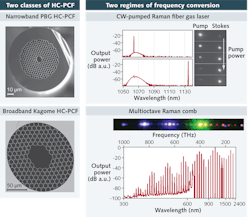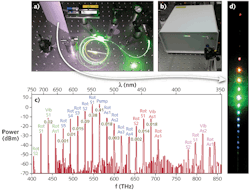NOVEL LASERS: Photonic microcell unleashes the full potential of gas lasers
FETAH BENABID, FRANÇOIS COUNY, and YING YING WANG
Despite the large variety of commercially available lasers and the staggering progress made in laser technology, some needs are still not addressed by existing lasers. The lack of laser emission in several spectral regions is a good example. One spectral region that exhibits a number of discrete gaps is the near-UV and visible (300 to 700 nm); coverage of this region is of importance to emerging laser-based biomedical applications that include flow cytometry to detect single cells; DNA sequencing; forensic detection of latent fingerprints and other trace evidence in crime scenes; and bio-agent detection, in which lasers are used to detect pathogens or bio-toxins.
These applications can require specific laser wavelengths (for example, yellow) that few existing lasers cover. Some of these applications require additional laser properties that may include a high spectral definition, a large dynamic range of optical power, and temporal profile control. Finally, because biologists are often not laser specialists, the simplicity of the laser design is also a prime concern. This situation makes the biophotonic field a stringent test of emerging laser technologies.
Current laser systems available for such uses rely on a bulky, free-space apparatus delivering a single laser line, sometimes with no spectral tunability; in the latter instance, several lasers may be required to address a single biophotonic application in which more than one wavelength is needed.
A recent solution involves using a supercontinuum-fiber source. Although such a source offers excellent spectral coverage, it suffers from low spectral power-density and poor spectral resolution; in addition, these sources require cumbersome monochromators and spectral filters to achieve no more than an incremental improvement on spectral resolution. Finally, supercontinuum sources have an intrinsically restricted bandwidth that does not extend into the UV spectral range; for example, even with highly UV-tailored fiber and a strong pumping source, the shortest wavelength achievable would be longer than 300 nm.
In other words, the laser end user is often pushed to adapt applications to fit the limited laser wavelengths that are available. Consequently, the advent of lasers able to emit at any wavelength while retaining compactness and other desired laser features would radically change the laser marketplace and applications.
Strong nonlinearities
The advent of the gas-filled hollow-core photonic crystal fiber (HC-PCF) and the subsequent development of its more integrated form, the photonic microcell (PMC), which consists of a gas-filled HC-PCF hermetically spliced to conventional all-solid optical fibers, holds the potential to be such a market-changing device. The PMC combines optical-fiber technology with the unique properties of gas-phase materials. The HC-PCF and PMC confines gases and light together at micrometer-squared-scale mode areas and over an interaction length a million times longer than achievable in free space for such small mode areas.
Strong nonlinear effects such as stimulated Raman scattering (SRS), electromagnetically induced transparency (EIT), and saturable absorption in gas-filled HC-PCFs have been demonstrated at extremely low light levels. The results of frequency conversion based on a Raman active-gas PMC are an excellent illustration of the capabilities of this photonic technology. These were triggered when SRS was demonstrated in 1 m of HC-PCF having a Kagome lattice (a straight-edged lattice consisting of hexagons and triangles) and a core filled with hydrogen; here, vibrational SRS was obtained at a pump threshold energy of only 800 nJ.1
Since that demonstration, the threshold has been decreased even further thanks to the use of ultralow-loss photonic-bandgap (PBG) HC-PCF. In this case, a 35 m length of hydrogen-filled PBG fiber with a bandwidth is centered around 1064 nm and transmission loss of 70 dB/km was used to generate rotational SRS at a peak-power threshold of only about 4 W. Furthermore, a near-quantum limit conversion to the Stokes was also observed.
In addition, Stokes generation excited with a continuous-wave (CW) laser pump has been demonstrated in an all-fiber system with only a few hundreds of milliwatts of pumping power.2 As a result of the long interaction length of the HC-PCF, the regime of Stokes amplification was significantly altered; transient SRS was obtained with lower powers and large pump pulses (several times the dephasing time of the Raman medium). This has been exploited to generate multi-octave coherent SRS combs from 12 ns laser pulses generated by a moderately low-repetition-rate, Q-switched single-frequency Nd:YAG laser (see Fig. 1).3
Compact and user-friendly
Thus, gas-phase materials are now a strong contender for next-generation lasers. The combination of a PMC filled with an appropriate Raman active gas and a pump laser source chosen from one of the few benchmark lasers that offer the desired laser features (for example, Nd:YAG lasers or erbium-doped fiber lasers) has all the ingredients to provide user-friendly laser systems that could emit at practically any wavelength. Furthermore, because of its optical-fiber form, it makes an excellent component to integrate (intrusion free) into any optical network such as the large market of telecom and the booming market of fiber laser.
As an illustration of the likelihood of this prospect, discrete comb lines were generated throughout the UV and visible spectrum in a compact, portable, battery-powered Raman gas HC-PCF laser.5 The system consists of several-meter-long PMC containing hydrogen gas at a pressure of 10 bar and is pumped with a compact high-repetition-rate (7 kHz) 532 nm diode-pumped solid-state microchip laser with an average output power of 20 mW and a peak power of 4 kW. The system was designed to address the stringent laser requirements of life and forensic sciences such as portability for on-ground diagnosis and data collection and laser emission at wavelengths not covered by existing lasers (see Fig. 2).In addition to its compactness, the PMC-based Raman converter exhibits exceptional frequency-conversion efficiency: 60% of the optical power is converted from the pump line to the rest of the spectral components. The output spectrum spans more than 450 THz and contains 23 lines extending down to the hitherto poorly covered UV-visible range. In addition to nine rotational (Rot) Raman sidebands of the initial pump from the S00(1) of ortho-H2, the spectrum counts one vibrational (Vib) Stokes component and two vibrational anti-Stokes (labeled as Vib-As) components from the Q01(1) transition of H2 (125 THz), each giving rise to a number of rotational sidebands, resulting in a spectrum comb extending from 712 nm in the near IR to 353 nm in the UV.
Such an output is an alternative to the conventional supercontinuum for applications where high spectral power density, resolved spectral components, or UV emission is needed. The measured far field and near field show characteristics of a single spatial mode for all the Raman components.4 Furthermore, based on the estimated upper limit of the linewidth of the different spectral lines of 100 MHz, the average power spectral density ranges from 2.4 W/GHz for the visible components to 0.7 W/GHz for the UV components. This is several orders of magnitude larger than what is obtained using supercontinuum sources, even with powerful pump sources.
To assess commercial impact of PMC technology, a turnkey physical package generating this comb has been developed under the scheme of the Engineering and Physical Sciences Research Council (EPRSC) Knowledge Transfer Account.The spectrum of the PMC-based laser exhibits spectral components with wavelengths that are highly sought after for applications such as in the biomedical field—for example, absorption spectra of 17 representative dyes from the family of Alexa Fluor, which are widely used as biological markers for the detection of fluorescent dyes in DNA sequencing (see Fig. 3).5 These absorption bands overlap or nearly overlap with the laser lines generated by the PMC-based laser. Using a tunable pump laser or an alternative Raman gas, and by tailoring the hollow core fiber optical transmission properties accurately, it is possible for this laser source to cover a much larger range of frequencies. The portability of existing pump lasers and the compactness of the PMC allow this new laser system to be packaged as a small device that requires limited maintenance or alignment.
REFERENCES
- F. Benabid et al., Science 298, pp. 399–402 (2002).
- F. Couny et al., Phys. Rev. Lett. 99, pp. 143903–143904 (2007).
- F. Couny et al., Science 318 (2007).
- Y.Y. Wang et al., "Compact and Portable Multiline UV & Visible Raman Laser in Hydrogen-filled HC-PCF," in ECOC (Vienna, Austria, 2009), postdeadline paper.
- http://www.invitrogen.com/site/us/en/home/References/Molecular-Probes-The-Handbook
Fetah Benabid is group leader, François Couny is Knowledge Transfer Fellow, and Ying Ying Wang is a PhD student at the Gas-Phase Photonic Materials Group, Centre for Photonics and Photonic Materials, Department of Physics, University of Bath, Bath, BA2 7AY, England; e-mail: [email protected]; www.bath.ac.uk/physics/groups/cppm.


